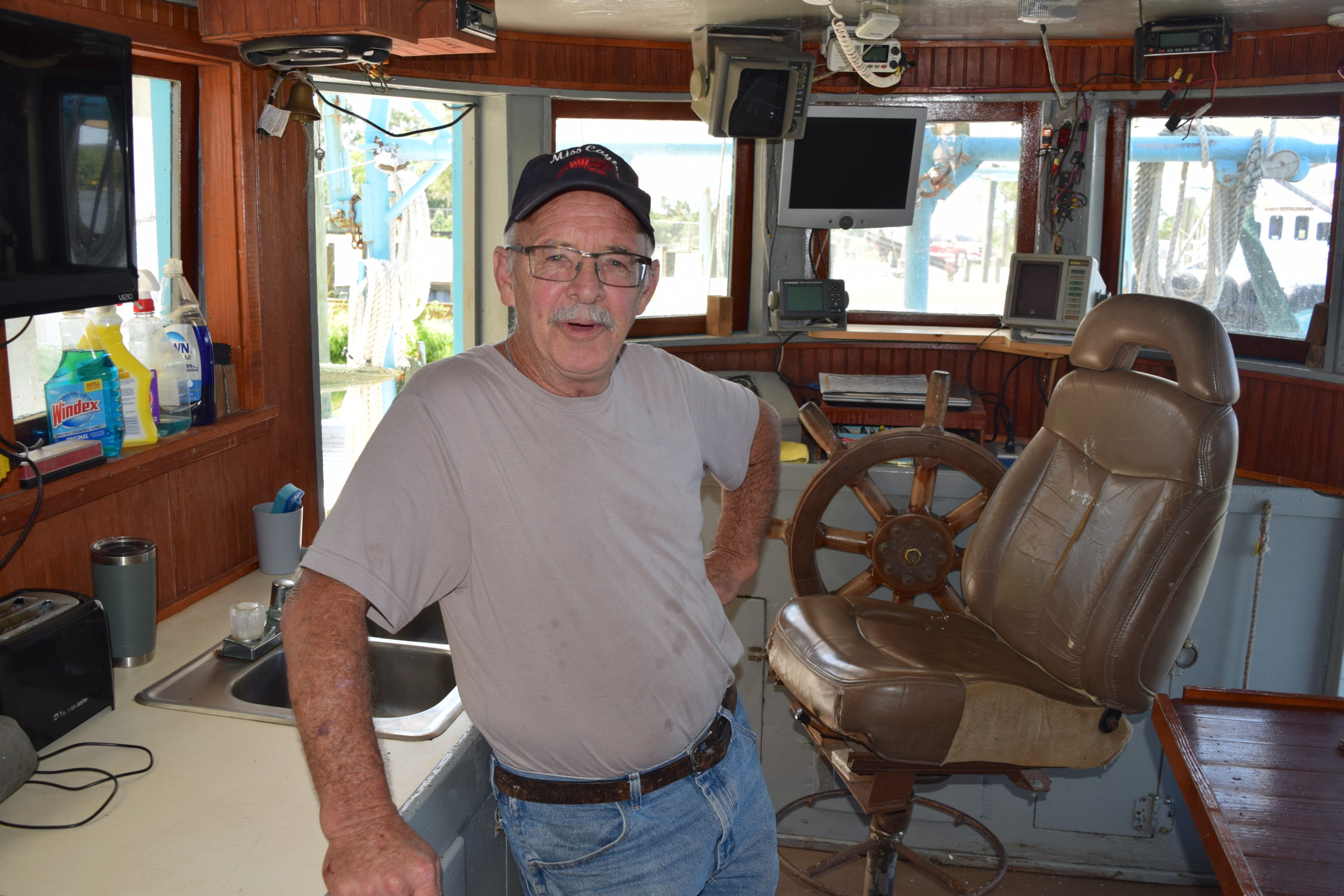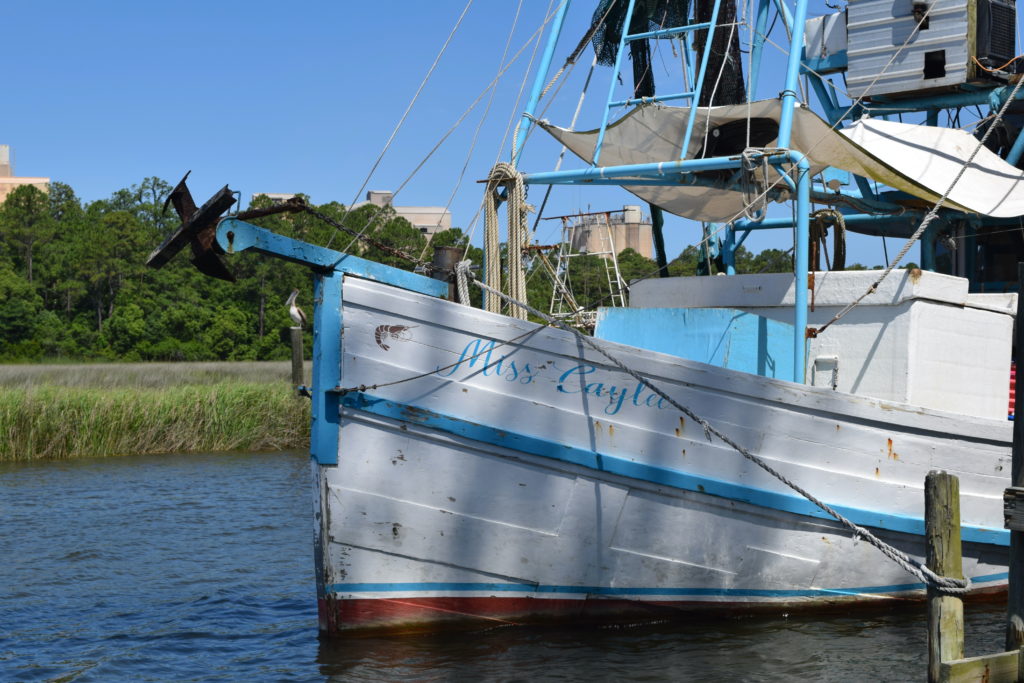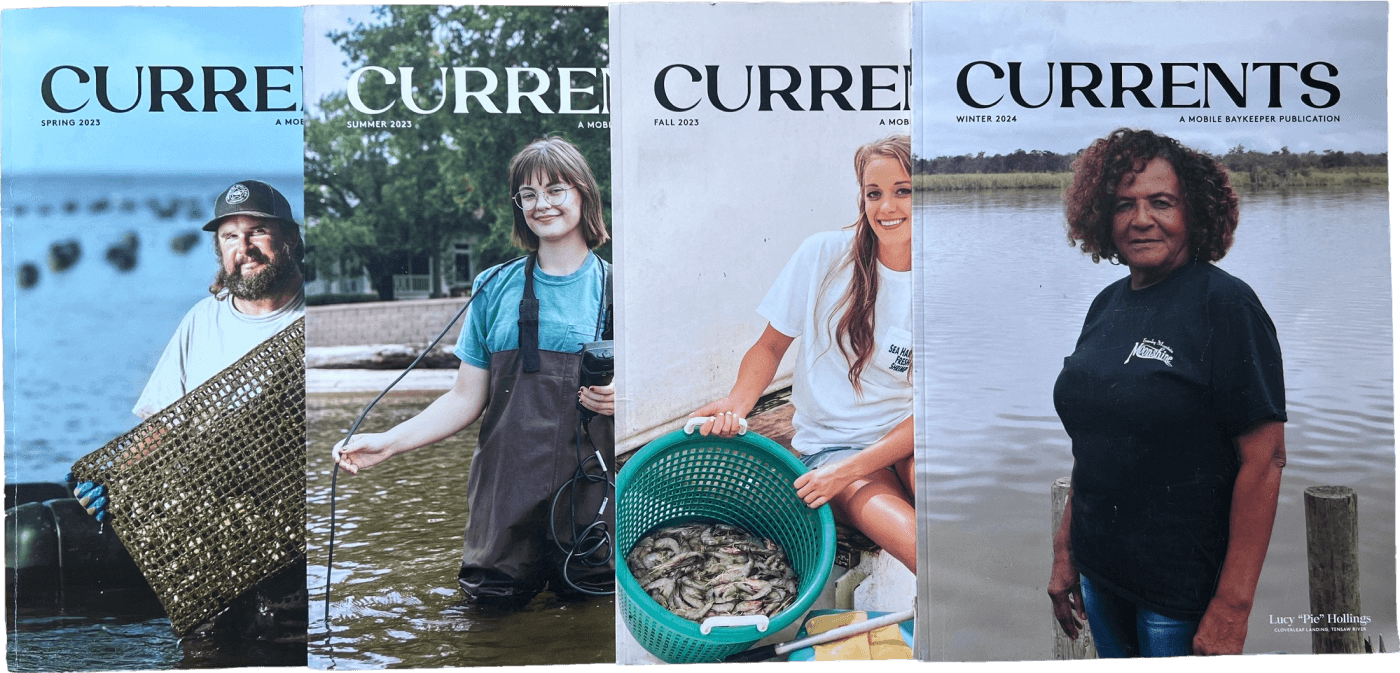
This article is from the fall 2024 edition of Mobile Baykeeper’s print quarterly, CURRENTS. The magazine is mailed to active members who have given more than $50 in the past year. To get on the magazine’s mailing list, donate here.
By Caine O’Rear
David Bryan is captain of the Miss Caylee. Built in 1942, it is the oldest fishing boat in Alabama working today. Bryan’s wooden craft is a style of trawler known as a Biloxi Lugger. These boats came out of the Biloxi shipyards in the late 1800s and rose to popularity as the first gas-powered fishing vessels on the market. We recently caught up with David and his wife, Debra. Together they run Miss Caylee Seafood from their dock on Deer River, near the Theodore Industrial Canal.
When did you get started as a shrimper?
I started working as a deckhand in 1975 and have been doing it ever since. I was fourteen, fifteen years old, looking for summertime work. I grew up on Hollinger’s Island and it was a thriving industry back in the day. Dog River was full of boats and they was always looking for help. I did it until ’78. Then I went to work in the Gulf on the big boats for three years. In 1981 I bought my first shrimp boat and I’ve been here on my own ever since.
In the late ’70s and ’80s prices were high and fuel and expenses was low. We was getting three times more in 1980 straight off the boat. The way we are now [most shrimpers] have to haul them to Bayou La Batre. Between the increase in imports, the high price of fuel, the cost of equipment, and just keeping your boat up, it’s a constant battle just to stay in business.
Tell me about the Miss Caylee.
She’s probably the oldest shrimp boat left in Alabama. She was built in 1942 in Biloxi, Mississippi. Not sure who the builder was. If I had a nickel for everything’s that been on it I probably could retire. It’s a lot of work. The people who had it before me done a lot of work to it too. These old lugger boats, there’s not many of them left. I’ve kind of grown fond of old boats. The boat I had before this was built in 1918 and I kept it up until about twenty-five years ago, and I finally had to retire it. This has been my next project. I do all the repairs myself. Like I said it’s six months of shrimping and another six months of maintenance to keep everything going.
How long is a typical outing and what’s the crew like?
Usually I keep the boat down to a captain and a one-man crew. That way the money’s a little better. The more people you have on the boat, the more you split the crew shares. Nowadays we work in and out every day. We’re a day boat now mainly, so that my wife can come in and keep our products sold. Back in the day we used to make trips to Louisiana and Mississippi … but the prices keep us from going anymore.
I’m getting up in age and like to make things a little easier for me. I’m winding my time down. There are not many young guys coming up behind us is one thing. I hate to see that. Used to be people begging you for a job. Now, it’s hard to find anybody that wants to go to work. This ain’t no easy job. It’s about one of the hardest jobs there is in the commercial fishing industry. You have to stay on deck from daylight until dark sometime. Take a break maybe to get a sandwich. You got to beat the heat and fight fish, shark bites. It takes a special person to want to be a deckhand on one of the boats. You got to love it to be able to do it.
A lot of it is the money has gone away from what it used to be. Back when I was a young un, that’s what got me into this business — the money. At 15, 16, the money I was making was unheard of. We’d go catch boatloads of shrimp and all I could think was “Man, look at all this money laying out here.” It used to be real good living. Nowadays, it’s just a living.
What’s the most dangerous thing you’ve seen?
Weather is our biggest fear. It can pop up in a minute. It hadn’t been too many years since we lost one of the best fisherman in Bayou La Batre, Mr. Danny Thompson. Had more sea-time than most people in Bayou La Batre. Got caught in the wrong kind of weather. Big water-spout or a tornado or something hit him, capsized his boat. He was caught in the cabin and died. Deckhand was on the stern and he happened to swim to a rock jetty.
My biggest fear really is keeping everybody safe and getting caught in bad weather. I try to watch it and stay close to home where I don’t get caught in it no more.
I do worry about people falling overboard, but that’s why I keep it down to one man. I can keep track of him. One thing about these old lugger boats is I always got my eye on the crew. Because they’re always up forward in front of me, working.
The biggest problem with the sharks is the bites in our nets. Some days we just get eaten to pieces. We work a half a day and then come in and sew the other half a day just to be able to work again the next day.
What kind of sharks?
Mostly here in the Bay it’s the black-tips and sandsharks and stuff like that.
Where are you harvesting the shrimp?
We work mostly in Mobile Bay. We don’t travel off much anymore because of the expense and cost of going out. We work in and out every day, to keep our product fresh. We have it here fresh for people and everything we catch here comes out of Mobile Bay and mostly the southern end of the Bay and that way we can keep our product here and dock everyday for people who wants to come pick up shrimp.
How was Mobile Bay changed since you got in the business?
In the early years in the first part of June we used to catch a lot of what they call the “Brazilian brownies,” the small brown shrimp, and over the years they seemed to have dwindled away and they don’t seem to come in the Bay no more and we don’t catch them like we used to. We don’t know why but we don’t see the small brownies in June anymore. In the past ten years or so we mainly only target the white shrimp. Most of what we catch are the white shrimp in Mobile Bay and the bigger shrimp and the way the prices are we have to target the bigger white shrimp to have something to sell because there’s no money in catching the small shrimp anymore.
In the earlier years the small brownies used to be worth good money; you could go out and and catch a good many every day and make a good day’s work out of it. Nowadays we don’t even see the brownies anymore and if we do the price is so low on them we can’t afford to catch them. It costs more in fuel and ice to catch them than what we get paid for. If there is some, we try to stay away from them and catch these bigger shrimp that we can get paid for.
How big of an an issue is pollution for shrimpers?
I don’t think pollution is part of our problem, though it may be some of it. You have sewage spills in the Bay on and off and they need to work on that problem — it can’t help any. Some of the time we have river run-off from the upper Delta … I’m not a biologist, I can’t say how much of that hurts us. Most of the time we get a lot of freshwater, it gets out of here pretty quick.
Right now I think the Bay is pretty healthy. The last month when we was out you’d catch small juvenile snapper, stone crabs, horseshoe crabs, and plenty of stuff from out in the Gulf which tells me the salinity is up in the Bay and the water is doing good. I don’t ever see the water get so stagnant it runs off our product or any of the sea-life. I believe it stays pretty well flushed out; Mother Nature is good about taking care of itself.

So you when you go out, you start at the trawling at the bottom of the bay?
We usually leave in the mornings a few hours before daylight and make about a two-hour run where we start fishing that. When it starts cracking daylight we’ll start working Mobile Ship Channel and start dragging our way back. By the time we get up to Middle Bay Light we start jacking everything up. Around here most days we get a real hard rising tide coming up in that ship channel. Some days it’s hard to drag against the tide. So when we get back this way we’ll run back to the lower part of the Bay and fish our way back. By the time we’ve done that a few times we’ve done enough and then we meet the wife for retail and start unloading our shrimp and taking care of customers.
Where do you sell your shrimp?
We mostly just catch them and retail them here at our dock. It’s gotten to the point that Bayou La Batre doesn’t pay enough for our shrimp to even worry about catching them and trying to haul them to Bayou La Batre. This is a family-run business. My wife handles all the retail stuff here at our dock on Deer River. We have a few restaurants we sell too. A few restaurants from Atlanta drive all the way down to pick up shrimp from us to get the quality they want. We have a few others we do business with but we sell most of what we catch right here at our own dock.
Do you think the Seafood Labeling Law will help the shrimping community?
Anything for the industry is good. The Seafood Labeling Law is just a start. The biggest move they need to make is to hamper the sale of the imports. If people knew what they were eating when they were buying it in the stores they’d move toward buying fresh, wild-caught Gulf shrimp, and not the pond-raised and such as that.
Most people need to hunt down their local commercial fishermen and try to buy their shrimp from one of them. If they went direct to the boat and bought their shrimp there they would never eat another shrimp out of a restaurant. They have no idea what they’re buying when they eat out of a restaurant. So the Seafood Labeling Law is a step in the right direction and I believe it will make a difference in the long run.
When did the imports become a problem?
It probably started ramping up in the ’90s when they started really putting the pressure on us with the imports. You get more and more countries doing the pond and farm-raised and sending their shrimp here.
In the last five years it’s really gotten bad. It’s gotten to where there are so many imports now the local freezers are stocked full and there’s nowhere to go with the shrimp. Last year you could hardly sell a shrimp here and this year it’s going to be the same problem. There’s so many imports on the market they don’t want to pay nothing for the domestic shrimp.
What’s the most popular shrimp y’all sell?
Debra: The most popular is the 10/15s during the summer, everyone wants the larger shrimp to grill and boil.
What’s the best way to cook them?
Debra: The larger shrimp, the best way is grilling them. Some people fry them and boil them but to me they get a little tough. But if you butterfly them and wrap them in bacon and put them on the grill for a little while, that’s fine.
I do this work because I want the people to know what they’re eating. It aggravates me so bad to know that people are out there buying these imported shrimp and they really don’t know what they’re eating. If they had a slight clue of how these shrimp were raised or where they came from they’d never buy another shrimp unless it was a domestic shrimp. We have top quality, they’re fresh, and you can taste the difference in it. And that’s why I try to keep the retail up, because the imports are killing us.
What do y’all charge?
The 10/15s, they normally go for $5 or $5.50.
What was the price for shrimp when you used to sell to the plants in Bayou La Batre?
David: Back in the ’80s when I got in the business I could take my shrimp to the dock and get $3.50 or $4 a pound for my big shrimp. And now here it is 2024 and I’m seeling the same shrimp to the public for $4. So the prices for shrimp haven’t gone anywhere. I was in the grocery store the other day and I see a one-pound roll for Zeigler’s Garlic Bologna for $5.99 a pound. I can’t get $5.99 a pound for anything I catch.
